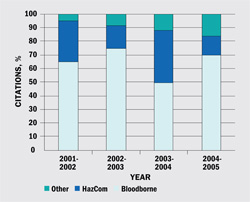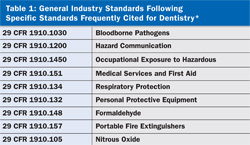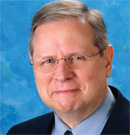Complying with OSHA Standards
Charles John Palenik, MS, PhD, MBA
As few as 30 years ago, more than 14,000 workers died annually because of work-related accidents, almost 2.5 million were disabled while working, and more than 300,000 new cases of occupational diseases and injuries were noted each year. The impact of worker injuries and illnesses in terms of lost productivity and wages, medical expenses, and disability compensation was enormous. Also immense was the level of human suffering.1-4
In response, the US Congress passed the Occupational Safety and Health Act of 1970 (OSH Act), which became effective in April 1971. The purpose of the OSH Act was “to assure so far as possible every working man and woman in the Nation safe and healthful working conditions and to preserve our human resources.” Under the OSH Act, the Occupational Safety and Health Administration (OSHA) was created within the Department of Labor.1-3
OSHA aims to ensure worker safety and health in the United States by working with employers and employees to create better working environments. Since its inception, OSHA has helped to cut workplace fatalities by more than 60% and occupational injury and illness rates by 40%. At the same time, US employment has doubled.1,2,5
As of June 2005, almost 133 million individuals have worked in 8.5 million workplace environments in the United States. In spite of recent successes, this year almost 6,000 American workers will die from workplace injuries with as many as 50,000 dying from illnesses in which workplace exposures were a contributing factor. Nearly 6 million people suffer nonfatal workplace injuries annually. The cost of occupational injuries and illnesses totals more than $170 billion a year.1
Health Care Workers
Health care is the second fastest growing sector of the US economy, employing more than 12 million workers. Women represent nearly 80% of the health care work force. Health care workers face a wide range of occupational hazards including needlestick injuries, back injuries, latex allergy, violence, and stress. Although it is possible to prevent or reduce health care worker exposure to these hazards, health care workers actually are experiencing increasing numbers of occupational injuries and illnesses. Rates of occupational injury to health care workers have risen over the past decade. By contrast, 2 of the most hazardous industries, agriculture and construction, are safer today than they were 10 years ago.3,4
OSHA Coverage
OSHA’s mission is to ensure the safety and health of US workers by setting and enforcing standards; providing training, outreach, and education; establishing partnerships; and encouraging continual improvement in workplace safety and health.3,4 OSHA monitors the health and safety of almost all workers in the United States. Coverage is applied directly by federal OSHA or through one of the 26 OSHA-approved state programs. The Connecticut, New Jersey, New York, and Virgin Islands plans cover public sector (state and local government) employment only. Employees in the private sector, including dental offices, are covered by federal OSHA.
OSHA does not cover self-employed persons, farms worked by family members, or working environments controlled by other federal agencies. States and territories that have approved local plans for private sector occupational safety and health programs must also have similar programs for state and local government employees.
OSHA Standards
OSHA performs its duties by promulgating legally enforceable standards. Standards may describe conditions or the use of practices, means, methods, or processes that are reasonably necessary and appropriate to protect employees in the workplace.1,4,6
Standards are often performance-based or performance achievements. For example, it is the responsibility of an employer to protect employees from patient body fluids in dental environments. The employer is challenged to ensure that employees are protected as much as possible. There are a number of ways this can be accomplished. Various processes and pieces of equipment can be involved. Employers can use a combination of work practices, engineering controls, and personal protective equipment to achieve the desired goal. OSHA does not endorse specific brands of equipment. Rather, it reviews the outcomes of the preventive efforts made by the employers and employees in a given workplace.1,3,6
In general, OSHA standards require employers to:
- maintain conditions or adopt practices reasonably necessary and appropriate to protect workers on the job,
- be familiar and comply with standards applicable to their establishments,
- ensure that employees have and use personal protective equipment when required for safety and health.
Standards for Dentistry
OSHA has developed a page for dentistry on its Web site, www.osha.gov/SLTC/dentistry/standards.html. There are currently no specific OSHA Standards or Directives for dentistry. However, exposure to numerous biological, chemical, environmental, physical, and psychological workplace hazards that may apply to dentistry are addressed in specific standards for general industry. This Web site provides links to those standards as well as references related to OSHA enforcement policy such as directives and interpretation letters. Some states have OSHA-approved State Plans and have adopted their own standards and enforcement policies.3,7
OSHA created a Standard Industrial Classification (SIC) System for individual types of workplaces. For dental offices and clinics the SIC Code 8021 is used while SIC Code 8072 denotes dental laboratories.7
OSHA has produced many standards. However, when a specific standard does not exist for a situation, the OSHA General Duty Clause applies. The Clause states that employers “shall furnish...a place of employment which is free from recognized hazards that are causing or are likely to cause death or serious physical harm to their employers.” State plans must set standards that are at least as demanding as the federal standards.1,3,6
In addition to the General Duty Clause, the dentistry profession must comply with all of the General Industry standards following specific standards (Table 1), which are frequently cited for dentistry (SIC code 8021, SIC code 8072).7
OSHA Inspections
The OSH Act authorizes OSHA to conduct workplace inspections to enforce its standards. Workplace inspections and investigations are conducted by OSHA compliance safety and health officers who are professionally trained in the disciplines of safety and industrial hygiene.1,7,8
Every establishment covered by the OSH Act is subject to inspection. OSHA enforces occupational safety and health regulations by inspecting workplaces, issuing citations, and imposing monetary penalties for violations of OSHA safety and health standards.1,7,8
OSHA has neither the staff nor the resources to inspect all of the workplaces in the US, so they have established a system of priorities based on the “worst first” approach. OSHA’s inspection priorities from highest to lowest are:
- Imminent Danger. Reasonable certainty that a danger exists that is expected to cause death or serious physical harm.
- Catastrophes and Fatal Accidents. Death or hospitalization of 3 or more employees (must be reported to OSHA within 8 hours).
- Employee Complaints. When the employee feels they are in imminent danger or threatened with physical harm.
- Programmed High-Hazard. Those establishments with lost workday rates at or above the most recently published Bureau of Labor Statistics national rate.
- Follow-Up Inspections. To ensure cited items have been abated.
Under the OSH Act, an OSHA compliance officer is authorized to “enter without delay and at reasonable times any factory, plant, establishment, construction site or other areas, workplace, or environment where work is being performed by an employee of the employer” and to “inspect and investigate during regular working hours, and at other reasonable times, and within reasonable limits, and in a reasonable manner, any such place of employment and all pertinent conditions, structures, machines, apparatus, devices, equipment, and equipment therein, and to question privately any such employer, owner, operator, agent, or employee.”
Nearly all inspections are conducted without any advanced notice. However, when advance notice of an inspection is given, the employer must inform the workplace representatives. OSHA usually does not have a warrant for an inspection when they first arrive and may not conduct warrantless inspections without an employer’s consent. It may, however, inspect after acquiring a search warrant or its equivalent based on administrative probable cause.1,7,8
If an OSHA inspector arrives to conduct an inspection, the following procedure should be used,6-10 including:
- Ask the inspector for credentials (a badge or identification card specifying that the person is an agent of OSHA).
- Ask whether the inspector has a warrant for the inspection. Do not demand that a warrant be present for the inspection to initiate. Simply inquire whether or not one exists.
- Before an inspection, the inspector will conduct an opening conference, during which the inspector explains why he or she is there and what he or she plans to do.
- Do not begin the opening conference without the attendance of the appropriate workplace representatives.
- After the opening conference, the inspector will conduct a walk-around inspection. Workplace representatives must accompany the inspector during the inspection. If affected employees in the department are represented by a union, ask the employees to designate a union representative to be present during the inspection.
- After the inspection, workplace personnel will meet to discuss the outcome and plan for action, as needed.
- If a notice of violation is received, it must be posted in the area of the offense for at least 3 days.
- After the OSHA inspector reports his or her findings to the office, the area director will determine what citations, if any, will be issued and what penalties will be proposed.6-8 The types of violations and penalties that may be proposed are:
- Other than serious violation. A violation that has a direct relationship to job safety and health, but probably would not cause death or serious physical harm. The maximum proposed penalty for this type of violation is $7,000.
- Serious violation. A violation in which there is substantial probability that death or serious physical harm could result, and that the employer knew, or should have known, of the hazard. The maximum proposed penalty for this type of violation is $7,000. Imminent danger situations are also cited and penalized as serious violations.
- Willful violation. A violation that the employer intentionally and knowingly committed. The employer either knew that the operation constitutes a violation, or is aware that a hazardous condition exists and made no reasonable effort to eliminate it. The penalty range for this type of violation is $5,000 to $70,000.
- Repeated violation. A violation of any standard, regulation, rule, or order where, upon re-inspection, another violation of the same previously cited section is found. Repeated violations can bring fines of up to $70,000.
- Failure to abate. Failure to correct any violations may bring civil penalties of up to $7,000 per day for every day the violation continues beyond the prescribed abatement date.
The 2 most common forms of citations given to dental offices and clinics involve the Bloodborne Pathogens and Hazard Communication Standards (Figure 1). From October 2004 through September 2005, a total of 108 citations resulted from 23 federal inspections. States and territories have issued additional citations.6,11
Being Proactive
There are steps that can be taken in a workplace to prepare for an unexpected visit from an OSHA inspector.1,3,4,6-11 These steps include:
- Join the Organization for Safety and Asepsis Procedures (OSAP; www.OSAP.org; 800-298-6727). OSAP is a nonprofit organization dedicated to helping dental professionals with their infection control and occupational safety and health needs. It offers training materials, answers to technical questions, a comprehensive Web site, and much more.
- Making sure the required OSHA poster, Job Safety & Health Protection (www.osha.gov/Publications/osha3165.pdf), is displayed in an area accessible to all employees.
- Identify, make available, and review all OSHA standards that apply tothe workplace.
- Ensure that all the required written programs, documents, and employee records are current.
- Audit safety and health compliance in-house.
- Designate a workplace compliance officer.
- Identify the persons that need to be present if there is an OSHA inspection.
- Make sure that employee training concerning OSHA standards is current, recorded, and correct.
- Regularly review employee records required by OSHA.
- Designate activities for all employees in the case of inspection.
During an Inspection
There are steps that a workplace can take during an unexpected visit from an OSHA inspector. 1,3,4,6-11 These include:
- Answer all questions truthfully, without directly admitting guilt.
- Never knowingly give false statements or intentionally mislead an inspector. If you do not know the answer to a question, explain that you are uncertain, and that you will look into the matter.
- Stay with the inspector at all times.
- Photographically record all areas inspected.
- Correct any identified violations immediately, if possible.
- Do not offer information unless asked for it.
- Do not talk about accidents or incidents that have occurred in the past unless specifically asked to do so.
- Be courteous. Do not be rude to the inspector or argue with them.
- Ask the inspector for a receipt for any documents provided.
- Take notes of any problems identified by the inspector and note any abatement procedures.
- Do not discuss political views regarding OSHA or the federal government.
After an Inspection
There are steps that a workplace can take after an unexpected visit from an OSHA inspector. 1,3,4,6-11 These steps include:
- Review all the items identified by OSHA and make corrections.
- Post any citations in the affected areas and wherever other notices are generally posted.
- If you do not agree with the OSHA citations, file a notice to contest the citations or participate in a hearing within 15 working days of the date you received notice.
- If a citation is received, it is advisable to contact outside counsel.
CONCLUSION
OSHA uses a variety of methods to train their inspectors. One method is sets of written instructions called directives, which establish policies and provide clarification to ensure uniform inspection procedures are followed. For dentistry, there are 2 important directives: Bloodborne Pathogens Standard (CPL 02-02-069-CPL 2-2.69 Enforcement Procedures for the Occupational Exposure to Bloodborne Pathogens; www.osha.gov/pls/oshaweb/owadisp.show_document?p_table=DIRECTIVES&p_id=2570) and the Hazard Communications Standard (CPL 02-02-059-CPL 2-2.59A Inspection Procedures for the Hazardous Waste Operations and Emergency Response Standard 29 CFR 1910.120 and 1926.65, Paragraph (q): Emergency Response to Hazardous Substance Releases; www.osha.gov/pls/oshaweb/owadisp.show_document?p_table=DIRECTIVES&p_id=1572 ). Dental offices and clinics can download and review these directives, which can help offices and clinics improve their level of compliance.
It is always best to be proactive. Communicating safety and health information and proper employee training are keys to success. Offices and clinics in which there is good communication and increased interest in health and safety reduce their chances of an OSHA inspection.
References
1. Occupational Safety and Health Administration. All About OSHA. Available at: https://www.osha.gov/Publications/osha2056.pdf. Accessed March 23, 20062. US Department of Labor, Bureau of Labor Statistics. Overview of BLS Statistics on worker Safety and Health. Available at: https://www.bls.gov/bls/safety.htm. Accessed March 23, 2006.
3. Miller CH, Palenik CJ. Infection Control and Hazardous Materials Management for the Dental Team, 3rd ed. St. Louis, Mo: Elsevier Mosby; 2005:343-365
4. Occupational Safety and Health Administration. OSHA Facts—2004. Available at: https://www.osha.gov/as/opa/oshafacts.html. Accessed March 23, 2006.
5. National Institute for Occupational Safety and Health. NIOSH Safety Health Topics: Health Care Workers. Available at: https://www.cdc.gov/niosh/topics/healthcare/. Accessed March 23, 2006.
6. Occupational Safety and Health Administration. Dentistry: OSHA Standards. Available at: https://www.osha.gov/SLTC/dentistry/standards.html. Accessed March 23, 2006.
7. Occupational Safety and Health Administration. Dentistry: OSHA Inspections ? 2002. Available at: https://www.osha.gov/Publications/osha2098.pdf. Accessed March 23, 2006.
8. Occupational Safety and Health Administration. Employer Rights and Responsibility Following an OSHA Inspection. Available at: https://www.osha.gov/Publications/osha3000.html. Accessed March 23, 2006.
9. Cornell University, Department of Environmental Safety. Do You Know What to do During an OSHA Inspection? Available at: https://www.ehs.cornell.edu/ochs/OSHA.Inspection.htm. Accessed March 23, 2006.
10. Princeton University, Department of Environmental Health and Safety. Health and Safety Guide: Section F1—Introduction to OSHA. Available at: https://www.web.princeton.edu/sites/ehs/healthsafetyguide/F1.htm. Accessed March 23, 2006.
11. Mills AC, Chillock CA, Edelman H, et al. OSHA safety requirements and the general duty clause. Compend Contin Educ Dent. 2005;26(Suppl): 14-19.
 |  | |
| Figure 1 OSHA Standards Cited for SIC 8021—Dental Offices and Clinics. (Adapted from: Occupational Safety and Health Administration. Dentistry: OSHA Standards.11) | *SIC code 8021, SIC code 8072. | |
| About the Author | ||
 Charles John Palenik, MS, PhD, MBA Charles John Palenik, MS, PhD, MBA on behalf of the Organization for Safety and Asepsis Procedures Director Infection Control Research and Services Indiana University School of Dentistry Indianapolis, Indiana | ||



